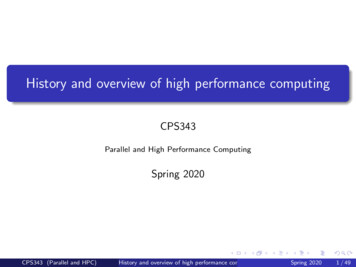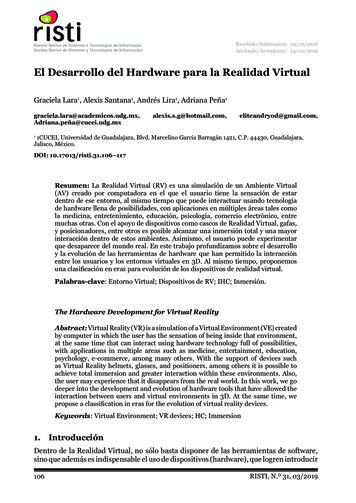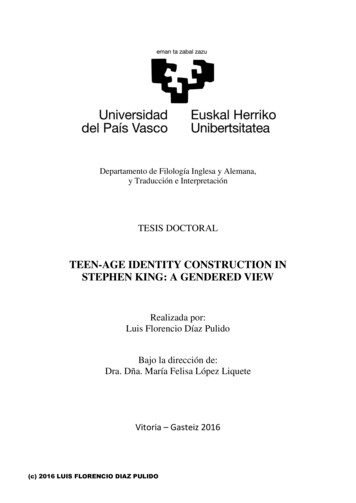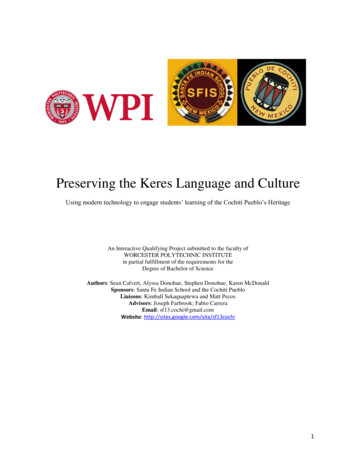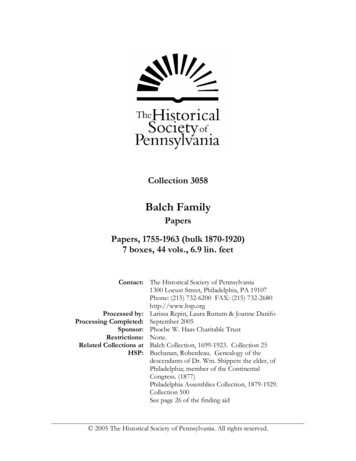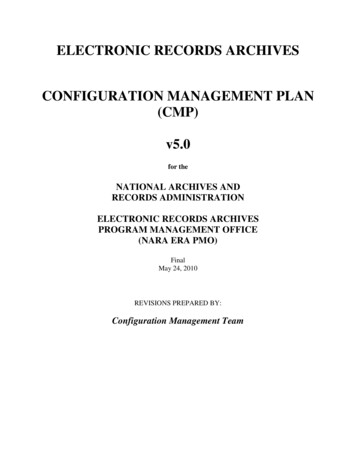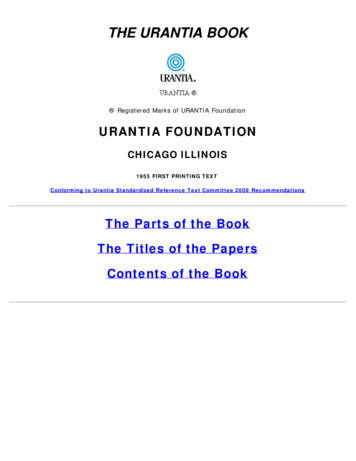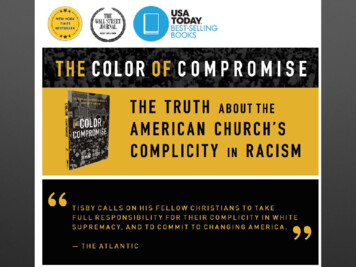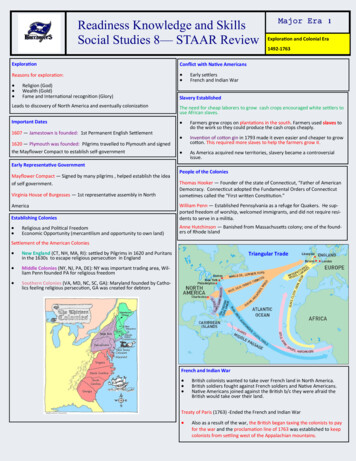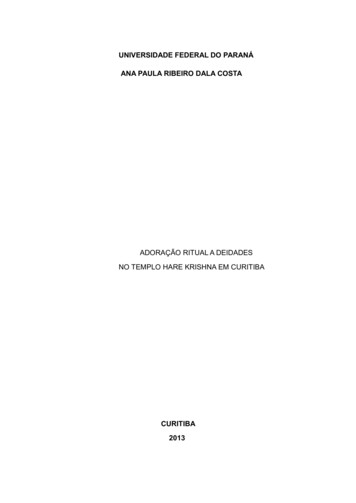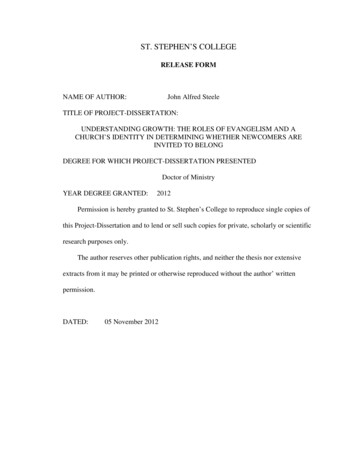
Transcription
ST. STEPHEN’S COLLEGERELEASE FORMNAME OF AUTHOR:John Alfred SteeleTITLE OF PROJECT-DISSERTATION:UNDERSTANDING GROWTH: THE ROLES OF EVANGELISM AND ACHURCH’S IDENTITY IN DETERMINING WHETHER NEWCOMERS AREINVITED TO BELONGDEGREE FOR WHICH PROJECT-DISSERTATION PRESENTEDDoctor of MinistryYEAR DEGREE GRANTED:2012Permission is hereby granted to St. Stephen’s College to reproduce single copies ofthis Project-Dissertation and to lend or sell such copies for private, scholarly or scientificresearch purposes only.The author reserves other publication rights, and neither the thesis nor extensiveextracts from it may be printed or otherwise reproduced without the author’ writtenpermission.DATED:05 November 2012
UNDERSTANDING GROWTH: THE ROLES OF EVANGELISM AND ACHURCH’S IDENTITY IN DETERMINING WHETHER NEWCOMERSARE INVITED TO BELONGA PROJECT-DISSERTATIONPresented toTHE DOCTOR OF MINISTRY PROGRAM COMMITTEEat St. Stephen’s CollegeEdmonton, Albertain partial fulfillment of the requirementsfor the Degree ofDOCTOR OF MINISTRYbyJohn Alfred SteeleVictoria, British Columbia
DedicationTo all who are called to share the Good News of God in Christ.
AbstractThe admission of children to communion on baptism without confirmation introduced adebate about how to define membership in the Anglican Church of Canada. Decliningmembership raised concerns around attracting new members. Using a Grounded Theoryapproach the researcher interviewed individuals from three numerically growingAnglican Church of Canada parishes. The purpose of the interviews was to determinetheir understandings of parish identity, evangelism, membership and belonging. Analysisof the recorded and transcribed responses from the Rector, one long term member andtwo newcomers included identification of key words, repeated phrases and commonthemes. Respondents did not identify belonging to the Anglican Church nor the Body ofChrist when referring to membership. The only criteria for belonging and membershipwere attendance and participation. In contrast to the normative method of groupendorsement that churches use to define membership respondents understoodmembership to be through self-definition. The paper concludes that growth was unrelatedto evangelism. Identity in general affected the way parishes understood people to belongbut it was the negative attitude to evangelism which had the greatest impact on theirunderstanding of belonging and invitation to belong.
AcknowledgementsMy thanks for helping bring this work to a conclusion are owed to many people. To BillClose for his encouragement to undertake this programme of study; the many DMincoordinators and the St Stephen’s community for their continued patience and support;Bishop Barry and Bishop James for their urging to get it done; my DMin Committee forall their work, Wally Fry, Logan McMenamie and Kim Murray; for Rene Warburton inguiding me in the sociological work; those who must remain unnamed but whogenerously participated in my study; Ann-Marie Gilbert for being the catalyst whichbrought this to birth with her expectations of deadlines, careful editing, insightfulcomments, laughter and time generously given; Angela McIndoe who improved my finalcorrected copy through her careful proofreading; the members of my parish who havecontinually encouraged me and held me in prayer; my Mother and Father for their prayersand knowing that I could do it; and my wife Franciane, and children, John-Daniel, Jessicaand Luc for living with this for so long. And those whom I have forgotten, do thou, OLord, rememberLord God, when you call your servants to endeavour any great matter, grant us also toknow that it is not the beginning, but the continuing of the same, until it be thoroughlyfinished, which yields the true glory; through him who, for the finishing of your work,laid down his life for us, our Redeemer, Jesus Christ.
Table of ContentsDedication . viAbstract. viiAcknowledgements. viiiTable of Contents . ixList of Tables . xivList of Figures . xvIntroduction . 1Chapter 1 Boundaries and Identity . 4Factors influencing Identity . 4Current Understandings of Identity . 5Mead: How One Understands The Good News . 5Woodbury: Lifestyle, Decisions and Faith Stances . 6Crawley: Congregation as Persona . 7Jones: Congregations As Theological Worlds . 7Bowen: Evangelising community . 9Hiebert: Bounded and Centred Sets . 10Reflections on set theory . 19Centred Set Theory . 19Chapter 2 Evangelism . 23My Foundation . 23Biblical Usage of the Word “Evangelism” . 25Is It Appropriate To Evangelize? . 28Exclusivist . 29Relativistic Pluralism . 29
Inclusivist. 30Implications For Evangelism. 32Proselytism . 34Where We Are In Current Thinking . 36Walter Brueggemann: Biblical Perspectives on Evangelism. 37Abraham: Believing to Belong . 38Finney and Hunter: Belonging to Believe . 40Cox and Butler Bass: Age of the Spirit, Belonging, Behaving, Believing . 41Wagner, McGavran, Wimber et al: Church Growth . 42Bowen, Percy, Willis: Anglican Approaches to Evangelism . 43Summary . 47Organizational Anglican Evangelism - Church Army . 48Reflections . 49Chapter 3 Conversion. 51Biblical Understandings of Conversion. 51Sociological Studies on Conversion . 55Participation in Conversion by the Convert: Richardson and Kilbourne, Barker. 56Sequential Model of Conversion: Proposal by Lofland and Stark; Criticism by Snowand Philips, Kox, Meeus and ’t Hart . 58Loss Of World View And Looking To Be Converted: Greil And Heirich . 61Conversion through Socialization: Long and Hadden . 62It Makes Sense To Convert: Gartrell and Shannon, Stark and Finke . 63
Acting Into A New Way Of Thinking: Bromley and Shupe, Snow and Machalek,Staples and Mauss . 65Conversion As A Lifestyle: Gooren . 67Cultural Factors in Conversion: Rambo . 69Longitudinal Study of Conversion: Barker . 77Summary . 80Chapter 4 Growth . 83Factors affecting growth . 83Natural Limitations on Growth - Preferred Size of Congregation, Staff Capacity,Demographics, Building Capacity . 83Positive and Negative Predictors of Growth. 86Congregational Similarities . 94Congregational Differences . 95From Strength to Strength . 96Summary . 97Numerical Maintenance – Numerical Growth . 99Chapter 5 Methodology . 101Grounded Theory Project . 101Rationale . 101Study Population . 102Data Collection . 102Data Analysis . 103
Chapter 6 Results . 104Defining Conversion And How It Occurs . 104Categories Of New Members In Church . 104Definitions, Evangelistic Action, Reaction To Work Of Evangelism And Invitation ToRespond . 104Impressions Of Congregational Understandings About Evangelism. 105How Is Membership In The Parish Defined? . 105What are Requirements For Membership? . 105What Makes A Person A Member? . 105How People Come To Belong . 105Responses To Request For Membership . 106Use Of Analytical Instruments To Help Determine Identity Of Church . 106Needs Which People Bring To The Church . 106Needs Which The Church Is Able To Meet. 106Desire And Reasons For Growth. 106Why People Are Attracted To The Church. 107Method By Which People First Become Aware Of The Church. 107Where Leadership Is Vested And The Effects Of Leadership On Growth . 107Evangelism Survey . 107Chapter 7 Discussion . 128Identity: What Makes Us Who We Are? . 128Definition of Membership: If You Attend – You’re In . 129Requirements: Belonging Before Believing . 131Required Beliefs: So What Do I Have To Believe? . 132If You Ask You’re In . 133Membership: What’s It All Mean? . 134Belonging: I Feel Therefore I Am . 135Defining Conversion: Change In Beliefs or Commitment to a Person . 136Evangelism: We Don’t Like The Word. Our Evangelism Is Good Deeds . 139Liturgical Evangelism: People Will Encounter God If They Come To Church. 141Evaluation: We Think We Are Doing Well . 142Circulation of the Saints . 144Needs We Can Meet: The Spiritual Needs People Bring . 145
Desire for Growth: People in Church or Disciples for the Kingdom . 145Attraction to Church: Why People Stay Once They Are There . 147Initial Awareness of Church: Finding Out About The Faith Community. 147Chapter 8 Conclusions . 148Summary . 148Appendices . 159Interview questions . 159Identity . 159Conversion . 160Evangelism . 160Growth . 161Summary . 161Bibliography. 162
List of TablesTable 1The Characteristics of Theological Worlds According to JonesTable 2The Category Christian as a Set17Table 3The Category Church as a Set18Table 4The Category Mission as a Set18Table 5Defining Conversion and How It Occurs109Table 6Categories of New Members in Church110Table 7Evangelism: Definition, The Action In Evangelism, Reaction to Work of Evangelismand Invitation to RespondTable 8111What the Congregation’s Understandings Is About Evangelism? Error! Bookmark notdefined.Table 99How Parish Membership is Defined113Table 10Requirements for Parish Membership114Table 11What Makes a Person a Member?115Table 12How People Come To Belong To A Parish116Table 13Responses to Requests for Parish Membership117Table 14Use of Analytical Instruments to Help Determine Identity of Church118Table 15Needs Which People Bring to the Church119Table 16Needs Which the Church Is Able To Meet120Table 17Desire and Reasons for Growth: Priests and Newcomers121Table 18Desire and Reasons For Growth: Long Term122Table 20Method by Which People First Become Aware of the Church124Table 21Where Is Leadership Vested and Effect of Leadership on Growth125Table 22Evangelism Survey Results Part 1126Table 23Evangelism Survey Result Part 2127
List of FiguresFigure 1Understanding the Good News .6Figure 2Seven Stage Conversion Process Model. 71Figure 3Correlation Among Strengths Exhibed by Strong Congregations . 96Figure 4Age Categories of People Attending Church in the Diocese of BC . 151Figure 5Age Categories of People Attending Parish A . 152Figure 6Age Categories of People Attending Parish B . 153Figure 7Age Categories of People Attending Parish C . 154Figure 8Average Sunday Attendance for the Diocese of BC 1992-2009 . 155Figure 9Average Sunday Attendance Parish A 1992-2009 . 156Figure 10Average Sunday Attendance Parish B 1992-2009 . 157Figure 11Average Sunday Attendance Parish C 1992-2009 . 158
IntroductionThe themes of mission and evangelism are interwoven in my life. Working out what itmeans to be an evangelical has been part of my life’s journey. I have had the immenseprivilege of serving God in many varied and diverse circumstances. I grew up in theSalvation Army with its strong emphasis on evangelism and reaching out to those in needwith comfort for the body and succor for the soul. My introduction to the sacramentsduring summer Bible camps, and worshipping in an Anglican context on joining theNavy lead me into the Anglican Church. Responding to my commitment at the age offourteen to serve in ordained ministry, I trained for ordination at Cranmer Hall, St John’sCollege, Durham, UK. I chose St John’s as it was an “Evangelical” college and thetheology department at the university was considered one of the best in the UK. Mypersonal tutor, Michael Vasey, asked why I as a Canadian had chosen to train at StJohn’s. I replied that as an evangelical I wanted to attend an evangelical college. Heasked what I thought it meant to be evangelical and I replied in terms of a high regard forthe Authority of Scripture and the Sacraments. After pondering for a bit Michael replied“John, you are not an evangelical. You are just Protestant.” I could understand what hemeant though I still believed I fit in a broad category of Evangelical rather than justProtestant. I could identify when my theological tutor, Stephen Sykes, was once pressedin class as to what he considered himself to be and replied “I am an evangelical as Lutherwas an evangelical.” While still linking being evangelical with a high regard for theauthority of Scripture and the Sacraments I also closely connect evangelical with1
2evangelism. To be evangelical is to share the good news of God in Christ and invitepeople to become part of that story. Part of my ministry has been spent in Africa (Uganda(85-86) and Burundi (91-94)). The areas in which I worked were deeply influenced bythe East African Revival. Evangelism was deeply ingrained in the life of the church.Evangelism was talked about regularly, evangelists were a recognized category ofministers in the church and Christians were expected to talk about their faith.The Bishops of the Anglican Communion initiated a Decade of Evangelism in 1988. Ihave been Diocesan Representative to the Primate’s Network on Evangelism, part of theCanadian Anglican Church’s response to the 1988 Lambeth Conference declaration of aDecade of Evangelism.The intent was for churches to be pro-actively engaged in evangelism. The generalresponse in the Canadian Anglican context was not strong. Part of this may be due to thechanges in society. The emphasis on pluralism in our society is often taken to mean that itis inappropriate to share one’s faith story. Where there is a sense that we have beenentrusted with the Great Commission 1, clergy and laity often do not have confidence or asense of how to go about sharing their faith stories. There can be the sense that this is notan Anglican thing to do, especially when evangelism is identified with actions of highpressure proselytising groups. What exactly is “evangelism” (and does it differ from“good news”) is a question often posed. Are corporal acts of mercy evangelism? Where1Matthew 28.19-20 Go therefore and make disciples of all nations, baptizing them in the name of theFather and of the Son and of the Holy Spirit, and teaching them to obey everything that I have commandedyou. NRSV
3people are engaged in sharing “good news” practically, is it evangelism if they may neverreach the point of explaining why they do what they are doing?I am interested in the area of identity and how people come to belong because the parishof which I am the Rector experienced a decline in numbers during the nineties. Theaverage age was over sixty-five. When the previous rector of the parish retired, thecongregation did an evaluation. With the assistance of people from the judicatoryauthority the parish examined its life and membership, identified positive attributes in thelife of the parish and opportunities for growth and change. They specifically wanted toreach out to younger families in the neighbourhood and involve them in the life of thechurch. They summarized their vision of their parish as wanting to be “an opendoor welcoming the surrounding community.” Since I was appointed to the position ofRector in this parish in January 1996 the average number of people attending Sundaymorning worship has increased from thirty to ninety. I am interested in learning thereasons why churches grow numerically and how this might be applied to other churchcongregations.These interests lead me to undertake a sustained academic study through the Doctor ofMinistry programme at St Stephen’s. My hope is that the following study will providesome insight and the results will assist churches to be more effective in reaching out toothers in sharing their faith stories and inviting people to become members of the goodnews communities who are followers of Jesus.
Chapter 1 Boundaries and IdentityFactors influencing IdentityThe understanding of a faith community’s identity will affect how they live out their lifeas a community, how open they are to the idea of inviting people to become part of theircommunity, and how willing they are in reality to allow new people to join.Some factors influencing this understanding include: the history of the faith community who it understands itself to be the underlying theological presumption – are we a Great Commandment 2Community or a Great Commission3 community? the demographics of the community way people dress the worship style engagement with evangelism.All these affect a faith community’s openness to welcoming newcomers – and allcommunities can be open - but the major factor is whether or not the community sees a2John 15.12 This is my commandment, that you love one another as I have loved you. NRSVMatthew 28.19-20 Go therefore and make disciples of all nations, baptizing them in the name of theFather and of the Son and of the Holy Spirit, and teaching them to obey everything that I have commandedyou. NRSV34
5need to evangelise i.e. has a desire for people to join their community and theirwillingness to ask people to join.Current Understandings of IdentityThe following researchers chosen offer their methods of identifying a congregation’s keycharacteristics.Mead: How One Understands The Good NewsMead 4 classifies a parish’s predominant understanding of church by the way theyunderstand the good news of Jesus. This resonated strongly for me as a useful method ofidentifying a congregation’s key characteristics and distinguishes clearly between thecorporate and private understanding of faith. It defines congregational identity in terms offuture hope and teleology.Mead produces a quadrant with an x axis bounded by “The only way to know God is aone-on-one, direct relationship. That’s the only way to know God” on one end to “Theonly way to know God is in the midst of God’s people, the church. That’s the only way.”on the other. The y axis is bounded by “The end and purpose of life is so to live that I amreunited with God at my death” to “The end and purpose of life is to participate withbrothers and sisters in building a human society of shalom, where peace and justice andlove reign.” Mapping the congregation’s understanding of the Good News clarifies whatfaith story it is sharing and articulates this story as part of its identity.4Loren B. Mead, Transforming Congregations for the Future, Once and Future Church Series (AlbanInstitute, 1994; reprint, 1995). p121
6Figure 1 Understanding the Good NewsCongregational owingWoodbury: Lifestyle, Decisions and Faith StancesWoodbury provides the Canadian perspective of someone experienced in congregationalgrowth and development. He suggests there are one hundred ways to be the church. 5 Heproposes three categories - Lifestyle, Making Decisions and Faith Stances - andsubdivides them as follows:5Clair Woodbury, 100 Ways to Be the Church (Winfield: Wood Lake Books, 1991).
71. Lifestyle: Ethnic, Agricultural, Industrial, Global2. Making Decisions: Historical, Organizational, Sociological, Psychological,Cellular3. Faith Stances: The Word, Experience of God, Tradition, Vital Community, SocialActionThese produce one hundred combinations of what might constitute primarycharacteristics of church. How the church functions will depend on
College, Durham, UK. I chose St John's as it was an "Evangelical" college and the theology department at the university was considered one of the best in the UK. My personal tutor, Michael Vasey, asked why I as a Canadian had chosen to train at St John's. I replied that as an evangelical I wanted to attend an evangelical college. He

